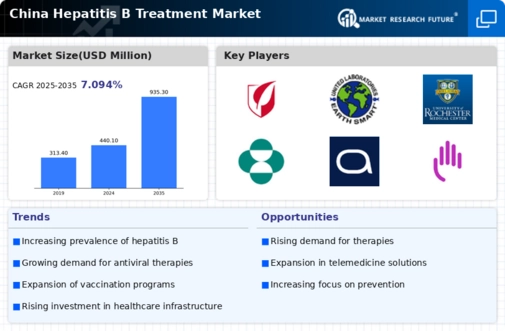The China Hepatitis B Treatment Market is characterized by a dynamic and competitive landscape, reflecting the increasing prevalence of hepatitis B in the region and the growing demand for effective treatment options. With a large population of carriers, the market has attracted numerous pharmaceutical companies focusing on developing and marketing antiviral therapies that cater specifically to the local populace.
Strategic alliances, partnerships, and innovative approaches to drug formulation and delivery are common in this sector as companies strive to secure their market share. Additionally, the regulatory environment in China influences market dynamics as companies navigate the approval processes for new treatments while considering the pricing and accessibility challenges that patients face. This competitive environment sets the stage for companies to continually improve their offerings while adapting to the unique healthcare needs in China.
Gilead Sciences
Gilead Sciences has made notable strides in the China Hepatitis B Treatment Market, establishing a robust presence through its innovative product portfolio that primarily focuses on antiviral therapies. Renowned for its research-focused approach, Gilead has successfully developed treatments that have significantly improved patient outcomes and adherence to therapy.
Their strength lies in their extensive experience in antiviral drug development coupled with strong research capabilities, enabling them to roll out novel solutions that address the challenges posed by hepatitis B in China. The company's commitment to advancing hepatitis B treatment options has positioned it as a leader in this market segment, ensuring that Gilead remains at the forefront of the competitive landscape while addressing the needs of healthcare providers and patients alike in China.
Tianjin Kingfriend
Tianjin Kingfriend is a prominent player in the China Hepatitis B Treatment Market, gaining recognition for its diverse range of products and services geared towards combating hepatitis B. The company has built its reputation on the development and manufacturing of high-quality pharmaceutical products, particularly focusing on antiviral medications.
Its strengths include a strong local presence, which allows it to effectively understand and respond to the market demands and regulatory requirements specific to China. Tianjin Kingfriend has successfully engaged in various partnerships and collaborations, enhancing its capability to innovate and expand its offering. Furthermore, the company's ongoing commitment to research and development facilitates the introduction of new therapies to the market.
In terms of mergers and acquisitions, Tianjin Kingfriend strategically aligns with other industry players to enhance its market penetration and broaden its product range, thereby reinforcing its position in the competitive Chinese healthcare landscape focused on hepatitis B treatment.

















